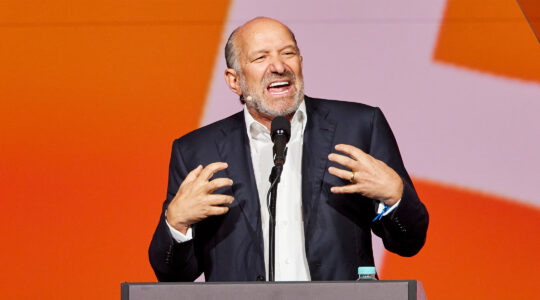Beyond perhaps identifying the date, June 14, few Americans today could identify any characteristics or traditions that surround Flag Day. Fewer still know that a Jewish philanthropist from St. Louis has been called "the father of Flag Day."
On June 14, 1777, Congress approved the design of the United States flag as designed by Betsy Ross: "Resolved that the Flag of the United States be 13 stripes alternate red and white, that the Union be 13 stars white in a blue field representing a new constellation." Citing an article in The New Yorker, a JTA bulletin from Flag Day 1930 introduces the role of German-born Jewish immigrant Benjamin Altheimer in inspiring a national celebration for this date:
Flag Day, observed June 14, Originated Ben Altheimer, Jewish Philanthropist, in 1910 (June 15, 1930)
…Mr. Altheimer in 1910 conceived the idea of setting aside a special day as Flag Day while attending a retreat formation at Fort Sam Houston, San Antonio, Texas, with which ceremony he became so impressed that he decided to devote his attention toward popularizing Flag Day and other patriotic demonstrations. He started the movement in St. Louis, where he lived at that time, and from where it spread to other cities. Flag Day was made a national holiday by President Wilson in 1916.
Wilson marked the holiday by way of a presidential proclamation and by leading a flag-laden parade down Pennsylvania Avenue. The Library of Congress’s American Memory project notes that "prior to 1916, many localities and a few states had been celebrating the day for years."
"Flag Day really started in 1861 in Hartford," asserted Craig Harmon, director of an independently operated website called the Lincoln Highway National Museum and Archives and an ardent Flag Day enthusiast. Two months after Confederate forces opened fire on Fort Sumter, an article from the June 14 edition of the Hartford Daily Courant expressed accord with a suggestion made in the editorial pages of another Hartford paper that this date be "celebrated in a quiet way by a general display of flags." This would effectively make this year the 150th anniversary of the first public observance of Flag Day.
A banker by profession, Altheimer juggled lay leadership roles with more than a half-dozen organizations during the 1920s, including the Union of American Hebrew Congregations, B’nai Brith, American Jewish Committee, the Non-Zionist Conference, National Jewish Hospital of Denver, Congregation Temple Emanu-El. He was also credited with founding "Bundle Day" in St. Louis in 1912, an annual collection of clothing for the poor that later grew to national prominence. In 1926, Altheimer was appointed to the finance committee — and by November voted treasurer — of a multi-denominational umbrella organization for rabbis called the Synagogue Council of America. With his legacy preceding him, it figures that the council promoted Flag Day observance in America’s synagogues:
Rabbis Asked To Speak On Flag Day Anniversary (June 10, 1927)
Rabbis of all synagogues were requested to speak on the 150th anniversary of the adoption of the flag, in a resolution passed by the Synagogue Council of America. Flag Day will be celebrated next ‘Tuesday. The resolution requests that this Saturday be devoted to Flag Day exercises in the synagogue.
It is planned to have a religious and patriotic service in front of the Capitol at Washington on the afternoon of Sunday, June 12. Ben Altheimer, who years ago began to advocate popular and religious observance of Flag Day, has been invited to join in the ceremony. Exercises are scheduled to be held in all parts of the country at the same hour as the Washington celebration.
While Altheimer’s legacy as a proponent of Flag Day celebration is clear, no direct link between Altheimer and Wilson has been established. "Altheimer is touted as the ‘father of Flag Day,’ but that’s kind of an inaccurate statement," said Harmon. After combing through the National Archives, presidential journals and appointment books, and after unsuccessfully attempting to locate any living relatives of Altheimer, Harmon suggests that there isn’t enough evidence to link the creation of natonal Flag Day in 1916 to the efforts of any one individual. "There were a lot of factors that played into that decision, but ultimately it was [Wilson’s] alone."
In the process of identifying forebearers of Flag Day, "people have a tendency to be broader in their strokes," cautioned Harmon. For example, Laura B. Prisk is sometimes referred to as "the mother of Flag Day" for writing a letter to Wilson in March 1916 requesting a national Flag Day celebration. Harmon instead prefers to dub Prisk "the mother of national Flag Day." And until he is able to establish a direct link, Harmon reserves the honorific title "father of Flag Day in St. Louis" for Altheimer.
Even by the 1930s, efforts to crown a patriarch or matriarch of Flag Day proved dizzying. Shortly before Flag Day 1932, The New Yorker was forced to file a second follow-up (paywall protected) to the initial 1930 Flag Day story referenced above to incorporate Prisk. "Flag Day is a closed issue with us," reads the highbrow tongue-in-cheek closing of the article. "We’ll hang up on you if you phone."
Altheimer himself appeared to have grown tired of garnering distinction for Flag Day. At the age of 84, in what could interpreted as either a flippant dismissal of a reporter or a revelatory moment, Altheimer took exception to the attention he drew before the holiday:
"Quit heaving laurels at me for Flag Day" pouts Ben Altheimer (June 14, 1934)
"It’s about time you stopped giving me credit for it," Benjamin Altheimer, eighty-four, who originated the celebration of Flag Day, said yesterday when: approached for a statement in connection with the annual commemoration which falls due today.
It was Mr. Altheimer who, in 1910, first conceived the idea and at whose suggestion President Woodrow Wilson set aside June 14 as a national holiday in 1916. In 1927 he was awarded the Cross of Honor by the United States Flag Association.
The aged philanthropist will probably spend the day quietly at the Harmonie Club [in New York City], as is his habit.
Nevertheless, the notion that Altheimer played some role in the evolution of Flag Day celebrations has endured. On March 21, 1996, while paying tribute to the Jewish War Veterans of America centennial, House Representative Paul E. Kanjorski (D-PA) said from the congressional floor, "One of its members, Ben Altheimer, was widely recognized for greatly influencing President Woodrow Wilson in designating June 14 as Flag Day."
Even if Altheimer’s legacy were to remain unchallenged from a factual standpoint, June 14 flag-waving continues to cede ground to a decades-long waning of national interest. Harmon was unsuccessful in his attempt to lobby for a nationally recognized celebration in front of the Capitol this year to commemorate the 150th anniversary of the first public Flag Day celebration. Part of the confusion may stem from discrepancies between reference books; Harmon found that World Book encyclopedia listed 1877 as the first public celebration, while Britannica has another date. Albeit disappointed, he remains determined to try again next year. If successful, 2012 would still bear numerical significance as the 150th anniversary of Flag Day being recognized by the Connecticut State legislature, and exactly 40 years since the last national parade in D.C. that took place in 1972.
In the meantime, those looking for a Flag Day celebration in the nation’s capital are welcome to join Harmon today at noon for a public gathering at the Capitol — or they could watch from home to gauge whether his back-up plan worked. "I sent press releases to fire department chiefs from New York to San Francisco to parade down Main Street," said Harmon. "They became the de facto guardians of the flag after 9/11," referencing the flags that fly atop fire engines.
Asked about the significance of Flag Day, Harmon stated with confident brevity, "It’s the umbrella under which everything operates." After a long pause, he elaborated. "The flag symbolizes everything about America; the idea of a melting pot — people coming from all parts of the world and one of the first things they see is the flag. It’s the symbol of America, basically."
JTA has documented Jewish history in real-time for over a century. Keep our journalism strong by joining us in supporting independent, award-winning reporting.





